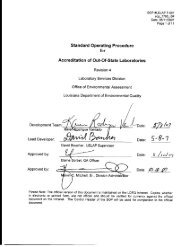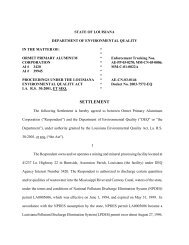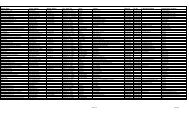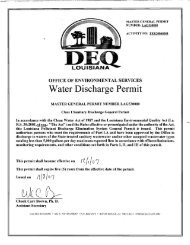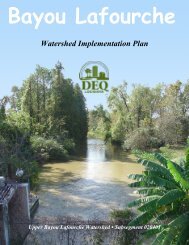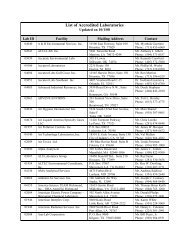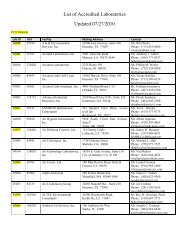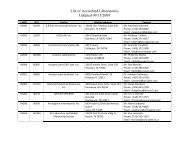UPDATE
UPDATE - Louisiana Department of Environmental Quality
UPDATE - Louisiana Department of Environmental Quality
- No tags were found...
Create successful ePaper yourself
Turn your PDF publications into a flip-book with our unique Google optimized e-Paper software.
Group of Norco Citizens Tour DEQ’s Air Lab<br />
Increasing citizen awareness and providing an<br />
open forum to address questions and concerns<br />
regarding the air quality in the Norco<br />
community were the main objectives driving a<br />
recent visit by a group of concerned citizens to the<br />
Louisiana Department of Environmental Quality’s<br />
(DEQ) Air Laboratory. The guided tour also served<br />
to highlight the importance of air monitoring and<br />
to provide accurate information on different types<br />
of toxic air pollutants. The tour was organized as<br />
a result of a collective effort between DEQ and the<br />
Shell Chemical/Motiva Refinery’s Good Neighbor<br />
Initiative.<br />
The Good Neighbor Initiative was developed by<br />
Shell Chemical LP and Motiva Norco Refinery and<br />
was launched in the summer of 2002. Since its<br />
inception, community outreach and participation<br />
has been extremely high. The main focus of the<br />
Good Neighbor Initiative is to improve community<br />
health and safety for the Norco area.<br />
In addition to community health and safety, a<br />
number of other projects and programs to address<br />
a variety of community concerns have been incorporated<br />
into the initiative. These include quality of<br />
life enhancements and environmental improvements.<br />
With a population of approximately 4,000 residents,<br />
the town of Norco is nestled in a one-mile<br />
area between the Shell and Motiva facilities located<br />
in St. Charles parish. Dwayne LaGrange, a Shell<br />
Community Relations Analyst coordinates the tours<br />
with the help of DEQ Environmental Scientist<br />
Manager, James Hazlett.<br />
The primary function of DEQ’s air laboratory is<br />
to serve as a support laboratory<br />
for operations of the<br />
Photochemical Assessment<br />
Monitoring Stations (PAMS).<br />
The U.S. Environmental<br />
Protection Agency (EPA)<br />
promulgated the PAMS rule<br />
in February of 1993. The<br />
rule required that a system<br />
of monitoring stations be<br />
strategically placed to record<br />
meteorological data and air<br />
pollutant data for ozone,<br />
NOx (nitrogens of oxide),<br />
and VOC (volatile organic<br />
compounds). The chief<br />
objective of PAMS data collection<br />
and reporting is to<br />
provide an air quality database<br />
to assist DEQ in evaluating,<br />
tracking the progress<br />
of, and, if necessary, refining<br />
control strategies to bring<br />
the Greater Baton Rouge<br />
area into attainment for ozone. NOx and VOC contribute<br />
to ozone formation.<br />
LaGrange stated “that building and enhancing<br />
community relations with the citizens of Norco and<br />
the surrounding areas through education is vital to<br />
the success of the program”. He encouraged the<br />
group of nine residents to ask questions. He added<br />
that the tour was designed for the purpose of<br />
addressing any concerns regarding the air monitoring<br />
process and how it affects their community and<br />
way of life.<br />
Also accompanying the group was Dr. Yvette P.<br />
Weatherton, Assistant Professor of Civil<br />
Engineering at Southern University. She is an<br />
expert in environmental chemistry and engineering<br />
and provides a neutral third voice to Shell Chemical<br />
Page 8<br />
Most air toxics originate<br />
and the citizens of Norco by<br />
delivering technical insight, education<br />
and support. According<br />
to Dr. Weatherton, two teams<br />
were established to manage the<br />
dynamics between Norco citizens<br />
and Shell. One team’s goal<br />
is communication and the other<br />
is technical. Both teams consist<br />
of twelve people representing<br />
community, industry, and citizens<br />
with an interest in the environment.<br />
Hazlett spent several hours<br />
conducting an extensive tour of<br />
the laboratory facility located<br />
off GSRI Road in Baton Rouge.<br />
He discussed and provided<br />
information on toxic air pollutants,<br />
also known as hazardous<br />
air pollutants. Hazardous air<br />
pollutants are those that cause<br />
from human-made sources,<br />
including mobile sources<br />
(e.g., cars, trucks, buses)<br />
and stationary sources<br />
(e.g., factories, refineries,<br />
power plants) as well<br />
as indoor sources<br />
(e.g. building materials and<br />
activities such as cleaning).<br />
or may cause cancer or other serious health problems.<br />
Examples of toxic air pollutants include<br />
benzene, which is found in gasoline; perchlorethlyene,<br />
which is emitted from some dry cleaning<br />
facilities; and methylene chloride, which is used as<br />
a solvent and paint stripper by a number of industries.<br />
Examples of other listed air toxics include<br />
dioxin, asbestos, toluene, and metals such as cadmium,<br />
mercury, chromium, and lead compounds.<br />
Most air toxics originate from human-made<br />
sources, including mobile sources (e.g., cars,<br />
trucks, buses) and stationary sources (e.g., factories,<br />
refineries, power plants)<br />
as well as indoor sources<br />
(e.g. building materials and<br />
activities such as cleaning).<br />
Some air toxics are also<br />
released from natural<br />
sources such as volcanic<br />
eruptions, forest fires and<br />
vegetation such as trees.<br />
At most air toxics sampling<br />
sites a single sample is<br />
collected for a 24-hour<br />
period every six days. DEQ<br />
follows the national sampling<br />
schedule set by EPA.<br />
EPA had designated several<br />
approved methods for the<br />
sampling and analysis of<br />
toxic air pollutants. DEQ<br />
uses EPA method TO-15,<br />
which is the method most<br />
widely used by EPA and<br />
state agencies nationwide.<br />
This method uses Summa<br />
Canisters and documents sampling and analytical<br />
procedures for the measurement of the VOCs<br />
subset of compounds listed in Title III of the<br />
Clean Air Act Amendments of 1990. It is designed<br />
for measuring toxic air pollutants down to a concentration<br />
of 0.5 parts-per-billion (ppb) but DEQ<br />
can typically measure concentrations as low as<br />
0.05 ppb.<br />
The tour was broken down and covered in parts<br />
based on five distinct laboratory areas.<br />
Part 1- Canister Storage Area<br />
The vast majority of air samples are collected in<br />
Summa Canisters. These canisters are specially<br />
treated to insure the stability of the samples during<br />
storage.<br />
L-r Dwayne LaGrange, Shell Community Relations Analyst, along with nine<br />
citizens of the Norco community, and Dr. Yvette P. Weatheron of Southern<br />
University<br />
Part 2 - Canister Clean Up & Certification Area<br />
All canisters must be certified as clean before<br />
being deployed for sample collection. The cleaning<br />
system uses a combination of heat and humid air<br />
flushing to remove all traces of contaminants from<br />
the canisters.<br />
The carbonyl analysis laboratory performs the<br />
extraction and analysis of sample cartridges used to<br />
sample the ambient air for the presence of carbonyl<br />
compounds (formaldehyde, acethaldetyde, acetone,<br />
etc.). Ambient air is the air flowing at a particular<br />
time and place outside of structures or facilities.<br />
The term ambient air is often used interchangeably<br />
with outdoor air.<br />
Part 3 - Field Support Laboratory<br />
This laboratory serves as the support laboratory<br />
for the deployment of the sampling equipment and<br />
field monitoring devices. The sampling devices<br />
include both active and passive canisters that collect<br />
samples over three to 24 hours. The laboratory<br />
Pictured are Summa Canisters, which collect toxic air<br />
pollutant samples. At most air toxics sampling sites a<br />
single sample is collected for a 24-hour period every six<br />
days. DEQ follows the national sampling schedule set<br />
by EPA.



